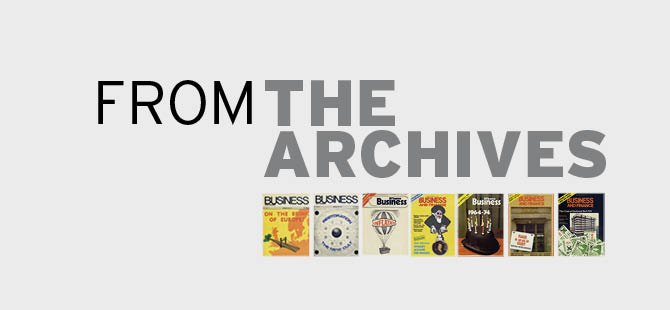As part of our regular trip into the Business & Finance 50-year archive, this Friday we take a look at the psychedelic 1970s and revisit some of the key news stories, as featured in Business & Finance, that have shaped Ireland.
The 1970s
 Decimalisation (1971)
Decimalisation (1971)
In 1968 finance minister Charlie Haughey announced in his budget speech that Ireland was going decimal.
Would the financial system collapse as one became two, three became four and nine became ten? “We’ll all be ruined,” was the common cry.
The changeover was set for February 15th 1971. It was not without its costs as old cash registers, adding machines and the like ended up on the scrap heap. CIE reckoned that the switch cost it £120,000, quite a lot of money in 1971.
Ireland joins Europe (1973)
After more than ten years of trying, Ireland finally joined the EEC, as it was then called, on January 1st 1973. On May 10th 1972 some 83% of the population had voted in favour of entry in a referendum.
Ireland’s chief negotiator was the then foreign minister, and later president, Paddy Hillery. While some commentators derided his softly-softly approach and complained that he had allowed himself to become ‘Brusselised’, the general opinion was that he had done a good job. He then became Ireland’s first European commissioner.
The industry with the most to fear from entry was the motor assembly industry. Business & Finance commented: “Other industries will suffer, but then this is known and must be accepted as the balancing element to the advantages which should flow from membership.”
After entry, discussion moved on to the Common Agricultural Policy and the benefits which would accrue to Ireland.
 The oil crisis (1973-74)
The oil crisis (1973-74)
Ireland was just settling into EEC membership when the Yom Kippur War broke out between Israel and the Arab states. The Arabs lost and retaliated by quadrupling the price of oil.
This triggered a global recession and an inflation explosion. Prophets of doom and gloom had a field day. A 1930s-style depression and a collapse of the global banking system were being predicted in some quarters.
On the domestic front, some relief was provided by Marathon’s announcement that it had found natural gas off Kinsale and offshore oil exploration started for the first time. A BP-led consortium which also included the Irish company Aran Oil was formed to search for the elusive Irish oil.
The inflation explosion (1973-74)
Inflation has already been rising throughout the late 1960s and into the early 1970s. In 1969 it reached 7.4% and by 1973 it had climbed into double digits and reached 11.4%.
Worse was still to come. Fuelled by the oil price hikes, it reached 17% the following year and then 20.9% in 1975. Hyperinflation beckoned but, fortunately, we stepped back from the brink with inflation falling to 7.6% in 1978. We were not quite cured, however. Fuelled by the Jack Lynch/Martin O’Donoghue public spending binge of 1977-79 it took off again, peaking at 20.4% in 1981.
The public spending binge (1978)
The rest of the world was discovering monetarism, but Ireland was determined to have one last spin of the discredited Keynesian wheel. Fianna Fáil was swept back into power in June 1977 with a then record 20-seat majority and an expansionist economic programme which saw the abolition of car tax and rates.
Between 1978 and 1980 the Exchequer borrowing requirement, which stood at 11% in 1976 and 10% in 1977, averaged 14%. The boom quickly turned to bust and inflation accelerated. In December 1979, Taoiseach Jack Lynch was toppled by his own party and Martin O’Donoghue, the Minister for Economic Planning and Development, and the man viewed as being largely responsible for the expansionist policy was dropped from the cabinet by the new Taoiseach, Charlie Haughey.
 Breaking the link with sterling (1979)
Breaking the link with sterling (1979)
Since 1826 the Irish pound had been tied to sterling. A lot of water had passed under the bridge since then, including independence and EEC membership, but the link with sterling survived intact.
Until 1979, that is. When the European Monetary System came into operation at the beginning of 1979 we joined, but the British did not. Initially we remained tied to sterling but when the UK currency rose sharply the Irish pound split with sterling for the first time in 153 years. Early predictions that the Irish pound would trade at a premium to sterling proved hopelessly optimistic. By July 1979 we were down to 89p sterling and by the end of 1990 the Irish pound had slipped under 80p sterling.
Next Friday we will be turning the spotlight in the 1980s.
*To read this article in its entirety, pick up a copy of the 50th Anniversary edition of Business & Finance, available now.





